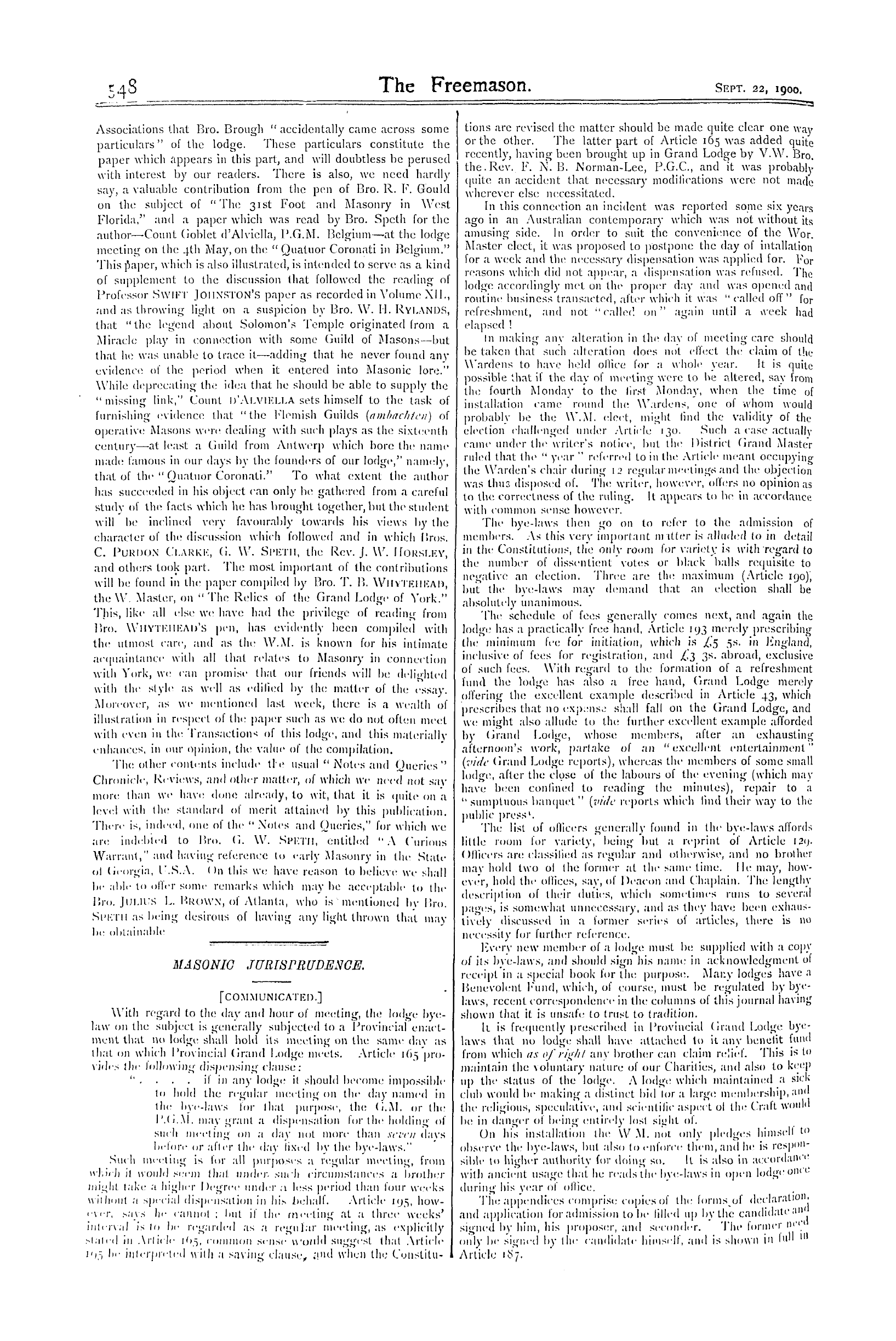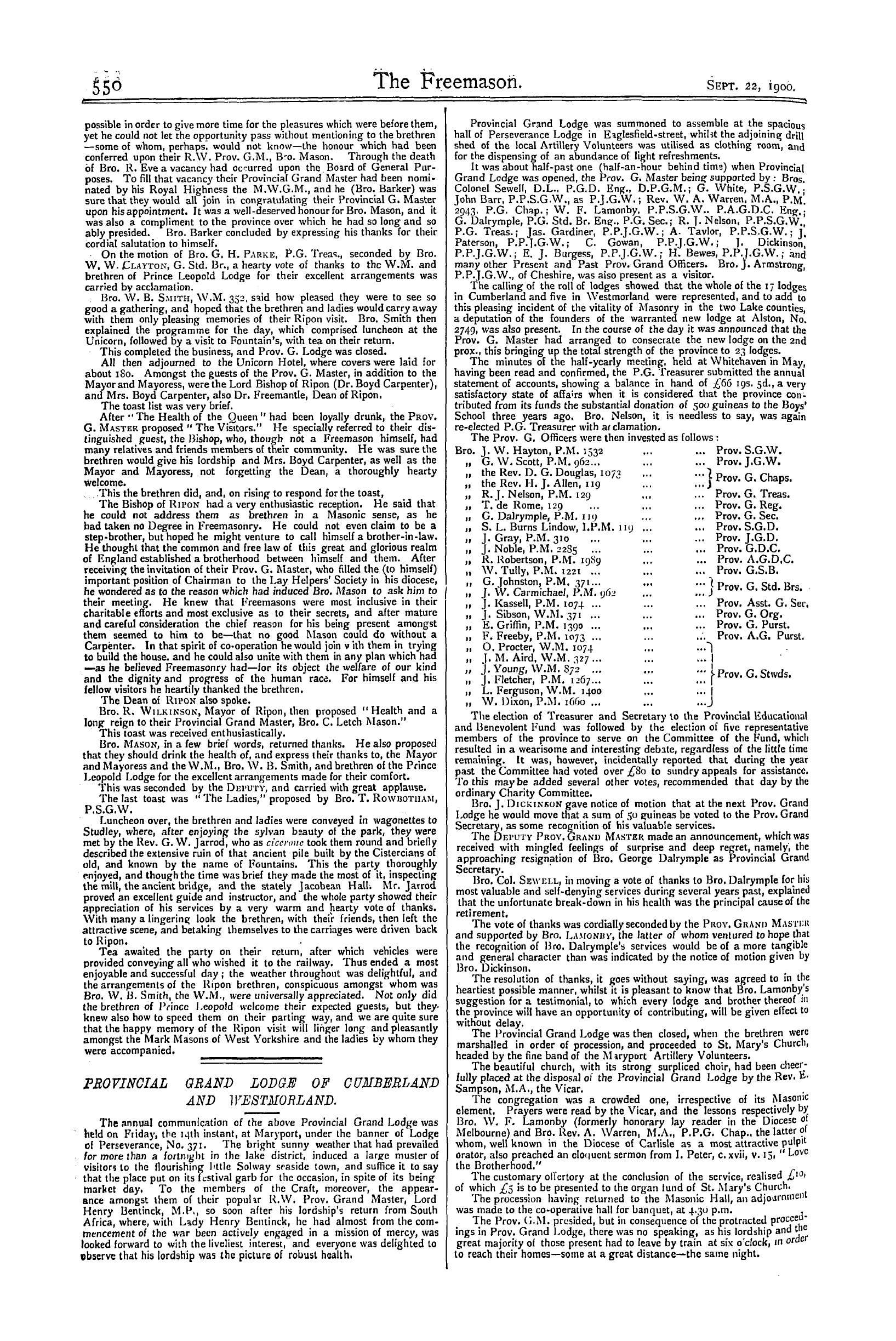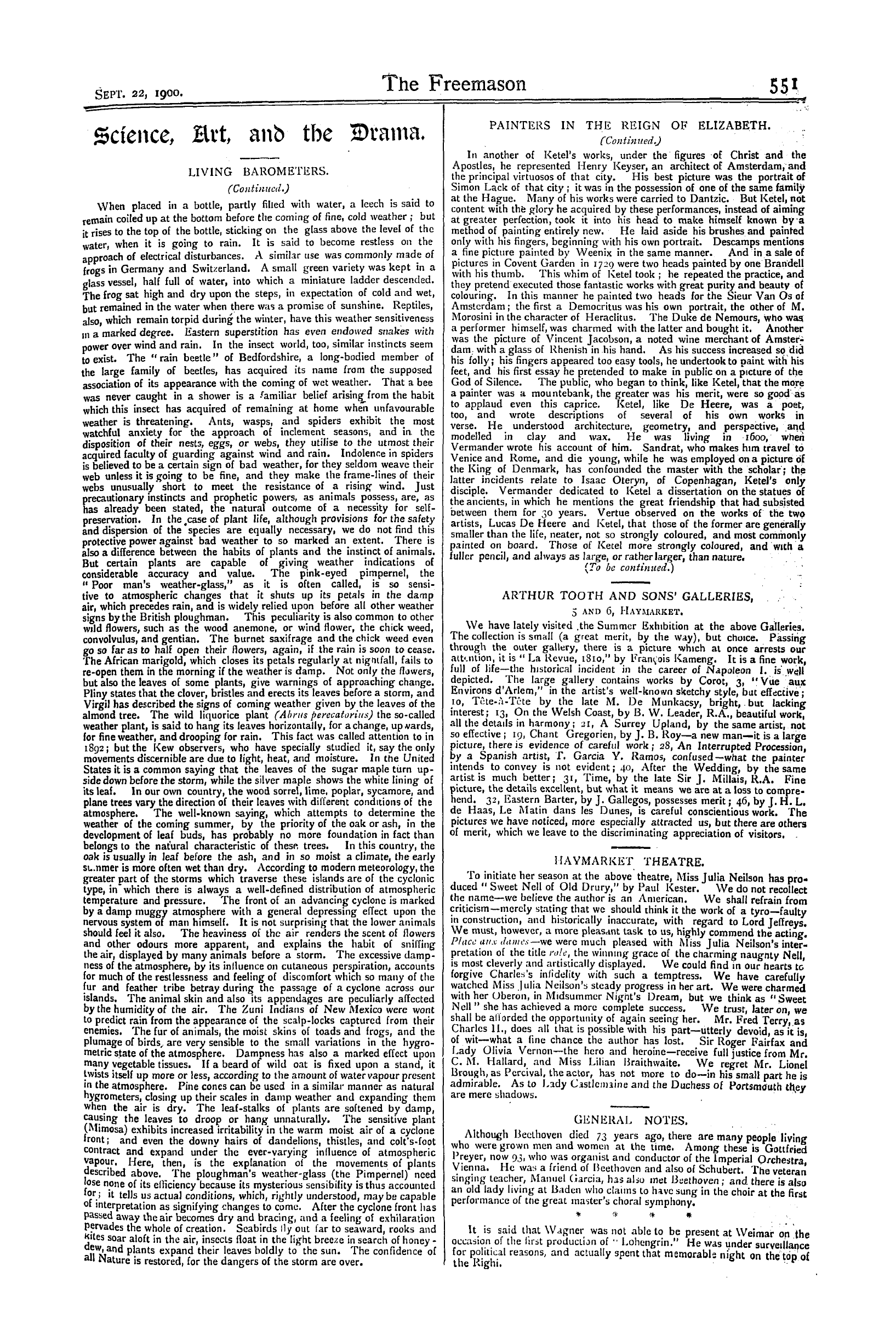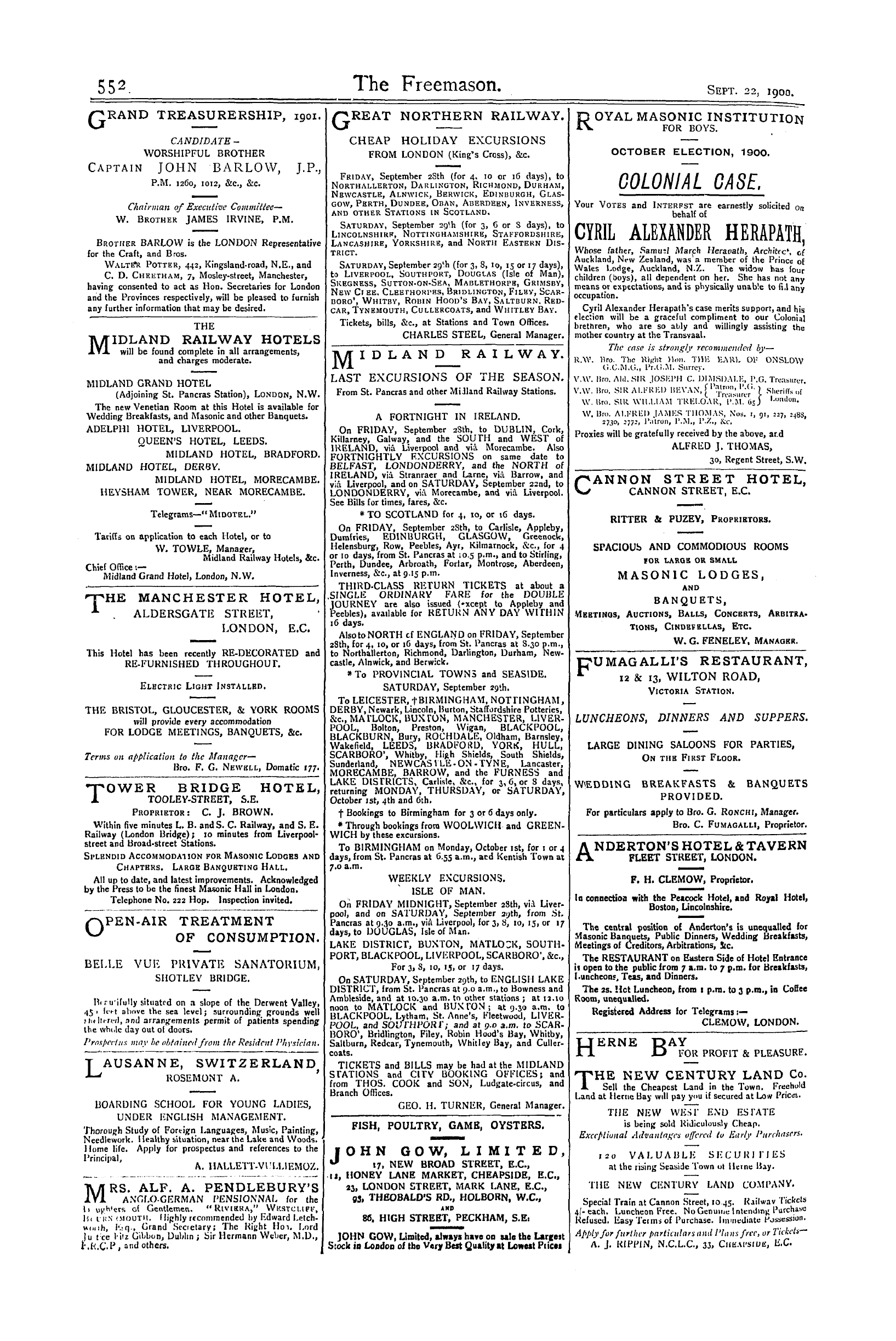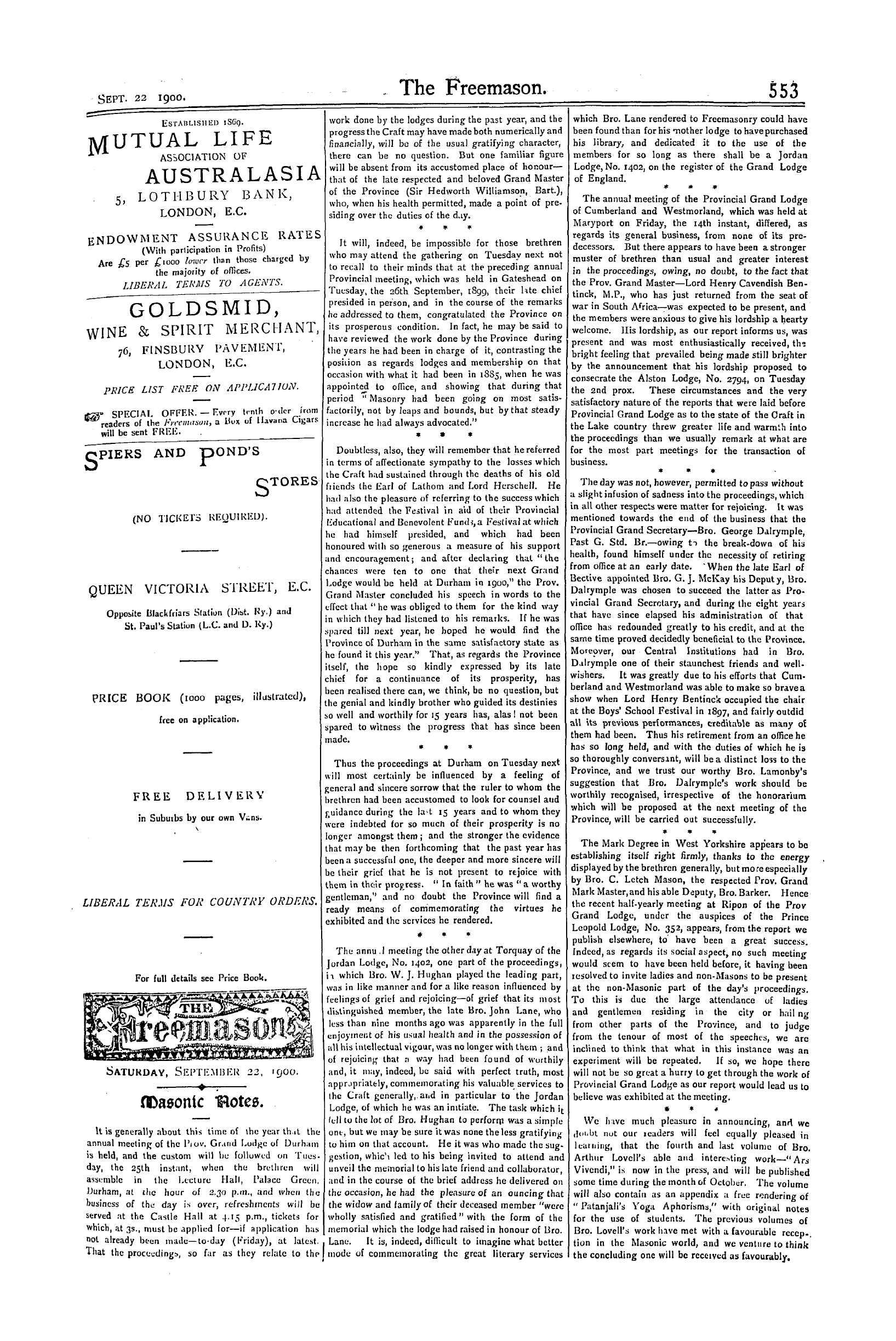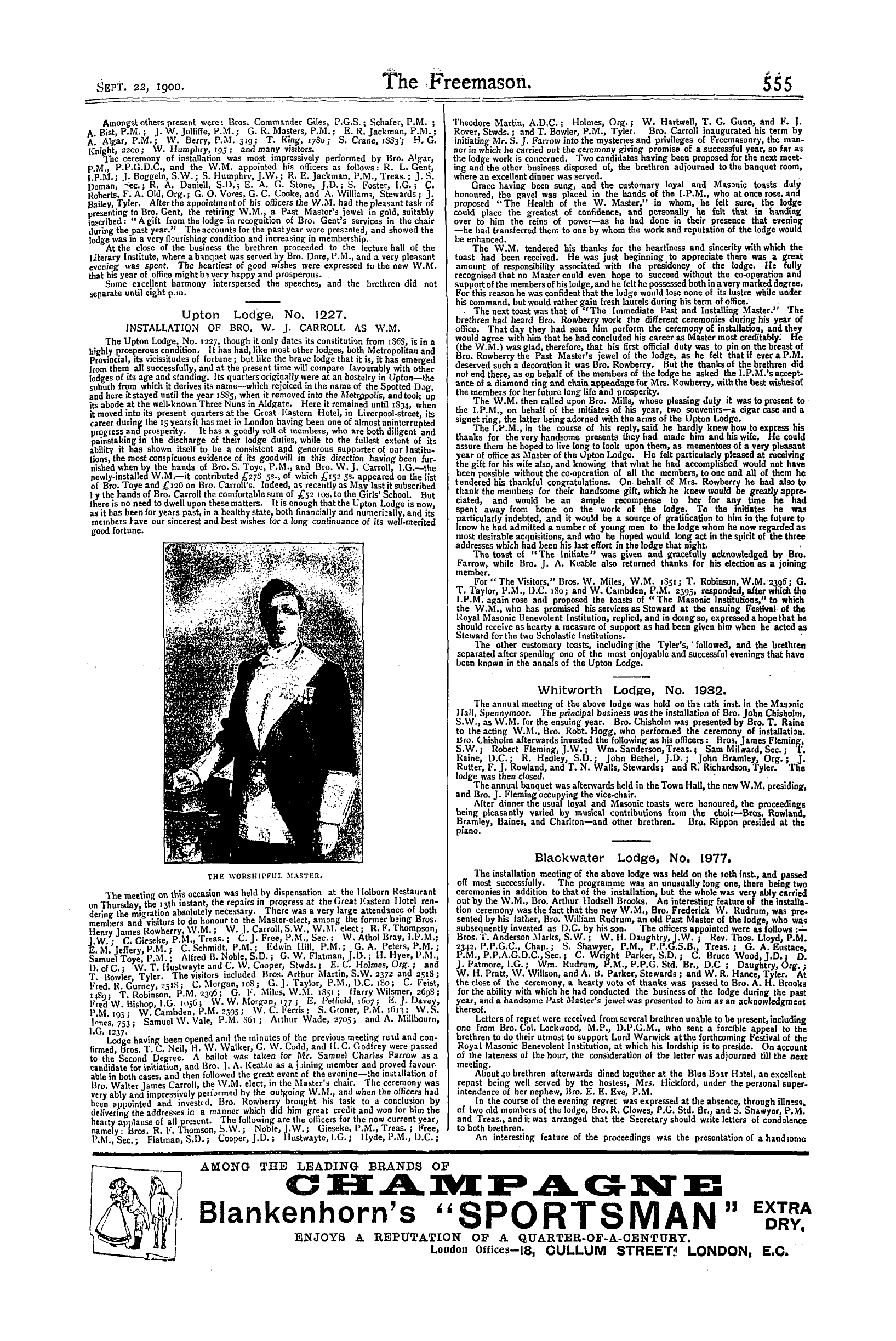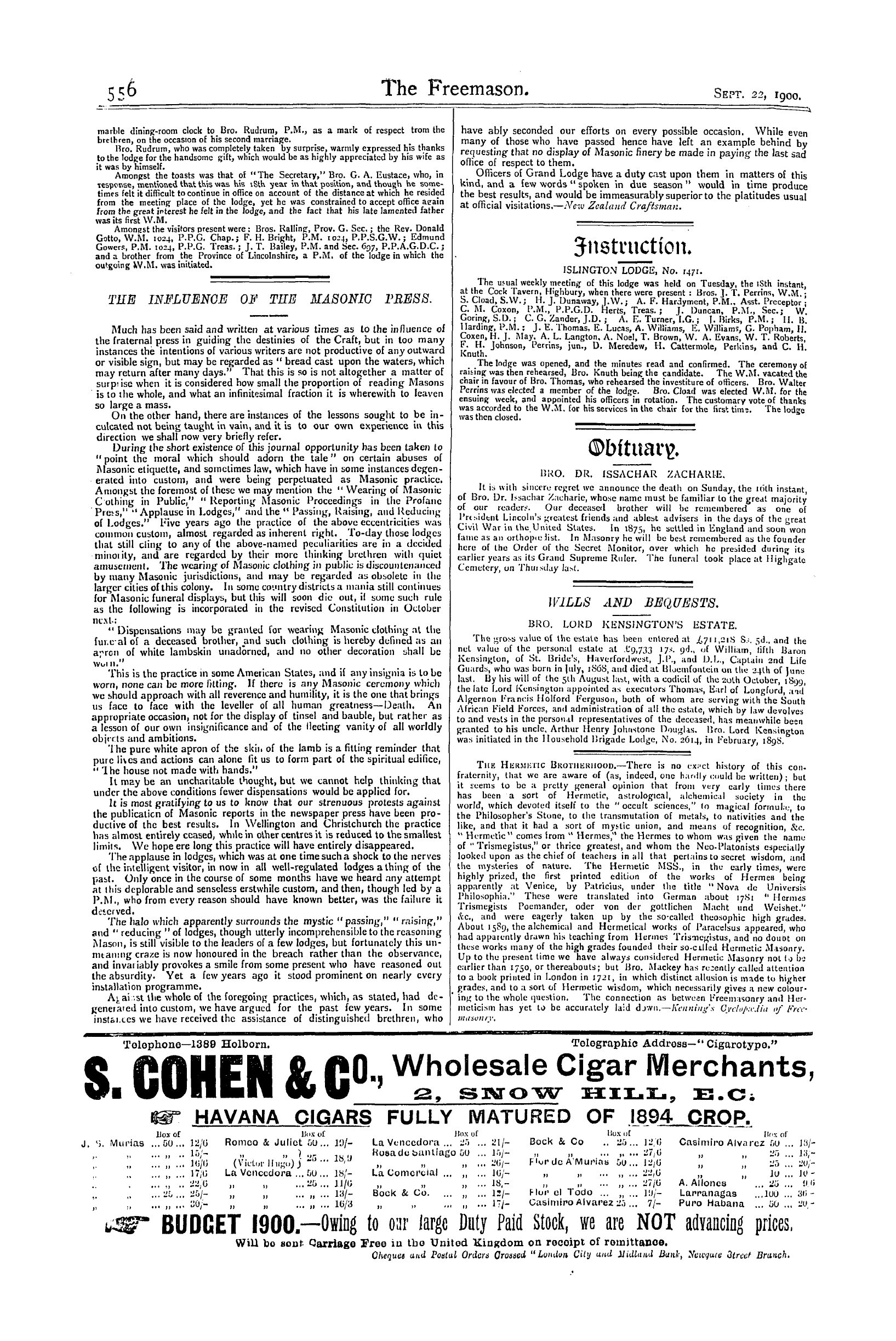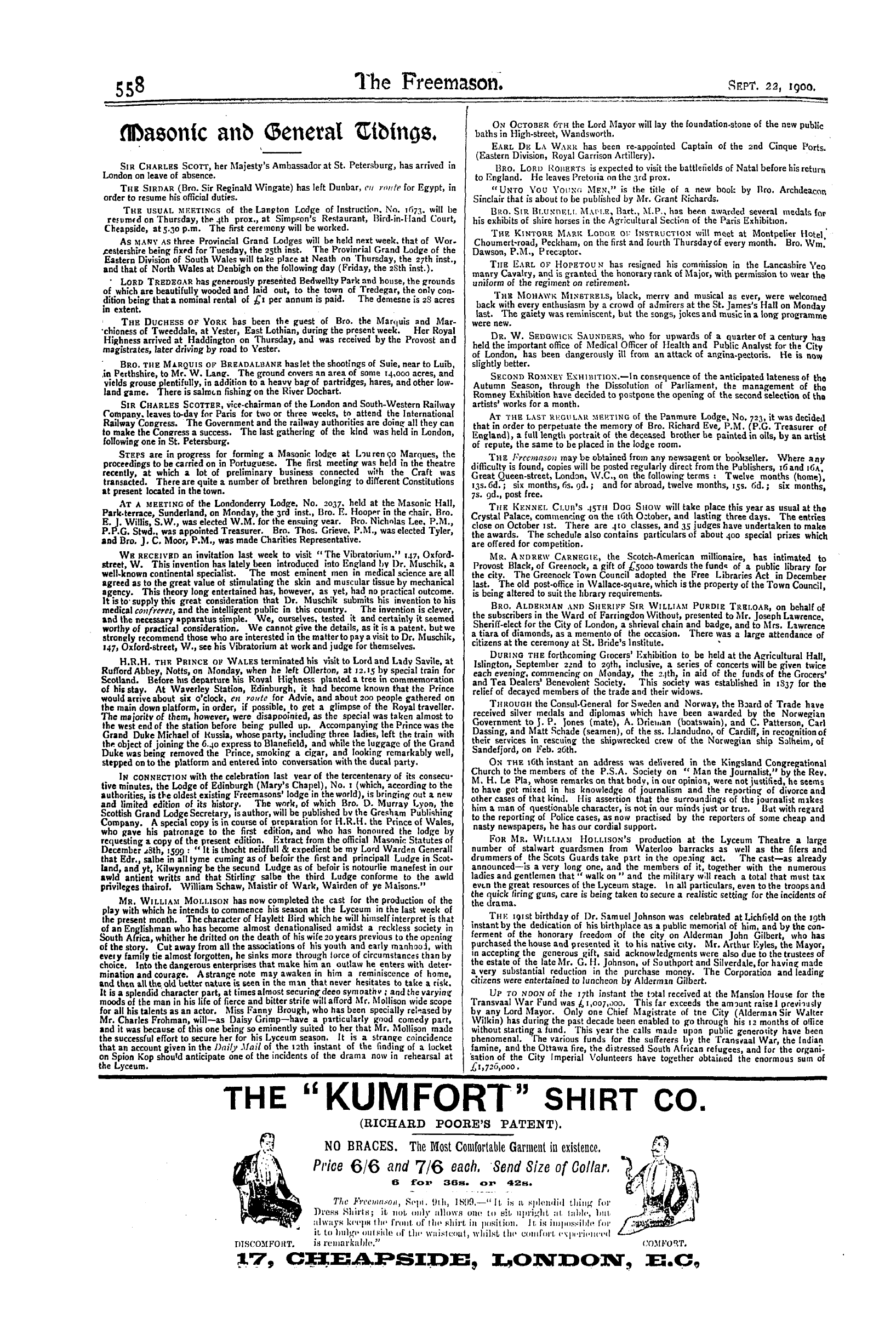-
Articles/Ads
Article Science, Art, and the Drama. Page 1 of 1 Article PAINTERS IN THE REIGN OF ELIZABETH. Page 1 of 1 Article ARTHUR TOOTH AND SONS' GALLERIES, Page 1 of 1 Article HAYMARKET THEATRE. Page 1 of 1 Article GENERAL NOTES. Page 1 of 1
Note: This text has been automatically extracted via Optical Character Recognition (OCR) software.
Science, Art, And The Drama.
Science , Art , and the Drama .
LIVING BAROMETERS . ( Continued . ) When placed in a bottle , partly filled with water , a leech is said to remain coiled up at the bottom before the coming of fine , cold weather ; bul it rises to the top of the bottle , sticking on the glass above the level of thc water , when it is going to rain . It is said to become restless on the approach of electrical disturbances . A similar use was commonly made of
frogs in Germany and Switzerland . A small green variety was kept m a glass vessel , half full of water , into which a miniature ladder descended . The frog sat high and dry upon the steps , in expectation of cold and wet , but remained in the water when there was a promise of sunshine . Reptiles , also , which remain torpid during the winter , have this weather sensitiveness in a marked degree . Eastern superstition has even endowed snakes with
power over wind and rain . In the insect world , too , similar instincts seem to exist . The " rain beetle" of Bedfordshire , a long-bodied member of the large family of beetles , has acquired its name from the supposed association of its appearance with the coming of wet weather . That a bee was never caught in a shower is a - amiliar belief arising from the habit which this insect has acquired of remaining at home when unfavourable
weather is threatening . Ants , wasps , and spiders exhibit the most watchful anxiety for the approach of inclement seasons , and in . the disposition of their nests , eggs , or webs , they utilise to the utmost their acquired faculty of guarding against wind and rain . Indolence in spiders is believed to be a certain sign of bad weather , for they seldom weave their web unless it is going to be fine , and they make the frame-lines of their
webs unusually short to meet the resistance of a rising wind . Just precautionary instincts and prophetic powers , as animals possess , are , as has already been stated , the natural outcome of a necessity for selfpreservation . In the . case of plant life , although provisions for the safety and dispersion of the species are equally necessary , we do not find this protective power against bad weather to so marked an extent . There is
also a difference between the habits of plants and the instinct of animals . But certain plants are capable of giving weather indications of considerable accuracy and value . The pink-eyed pimpernel , the " Poor man's weather-glass , " as it is often called , is so sensitive to atmospheric changes that it shuts up its petals in the damp air , which precedes rain , and is widely relied upon before all other weather
signs by the British ploughman . This peculiarity is also common to other wild flowers , such as the wood anemone , or wind flower , the chick weed , convolvulus , and gentian . The burnet saxifrage and the chick weed even go so far as to half open their flowers , again , if the rain is soon to cease , The African marigold , which closes its petals regularly at nightfall , fails to re-open them in the morning if the weather is damp . Not only the flowers ,
but also the leaves of some plants , give warnings of approaching change . Pliny states that the clover , bristles and erects its leaves before a storm , and Virgil has described the signs of coming weather given by the leaves of the almond tree . The wild liquorice plant ( Abrtis perccatoritts ) the so-called weather plant , is said to hang its leaves horizontally , for a change , upwards , for fine weather , and drooping for rain . This fact was called attention to in
1892 j but the Kew observers , who have specially studied it , say the only movements discernible are due to light , heat , and moisture . In the United States it is a common saying that the leaves of the sugar maple turn upside down before the storm , while the silver maple shows the white lining of its leaf . In our own country , the wood sorrel , lime , poplar , sycamore , and plane trees vary the direction of their leaves with different conditions of the
atmosphere . The well-known saying , which attempts to determine the weather of the coming summer , by the priority of the oak or ash , in the development of leaf buds , has probably no more foundation in fact than belongs to the natural characteristic of these trees . In this country , the oak is usually in leaf before the ash , and in so moist a climate , the early su . nmer is more often wet than dry . According to modern meteorology , the
greater part of the storms which traverse these islands are of the cyclonic type , in " which there is always a well-defined distribution of atmospheric temperature and pressure . The front of an advancing cyclone is marked by a damp muggy atmosphere with a general depressing effect upon the nervous system of man himself . It is not surprising that the lower animals should feel it also . The heaviness of the air renders the scent of flowers
and other odours more apparent , and explains the habit of sniffing the air , displayed by many animals before a storm . The excessive dampness of the atmosphere , by its influence on cutaneous perspiration , accounts for much of the restlessness and feeling of discomfort which so many of the fur and feather tribe betray during the passage of a cyclone across our islands . The animal skin and also its appendages are peculiarly affected
by the humidity of the air . The Zuni Indians of New Mexico were wont to predict rain from the appearance of the scalp-locks captured from their enemies . The fur of animals , the moist skins of toads and frogs , and the plumage of birds , are very sensible to the small variations in the hygrometric state of the atmosphere . Dampness has also a marked effect upon many vegetable tissues . If a beard of " wild oat is fixed upon a stand , it
twists itself up more or less , according to the amount of water vapour present in the atmosphere . Pine cones can be used in a similar manner as natural h ygrometers , closing up their scales in damp weather and expanding them when the air is dry . The leaf-stalks of plants are softened by damp , causing the leaves to droop or hang unnaturally . The sensitive plant ( Mimosa ) exhibits increased irritability in the warm moist air of a cyclone
front ; and even the downy hairs of dandelions , thistles , and colt ' s-foot contract and expand under the ever-varying influence of atmospheric vapour . Here , then , is the explanation ol the movements of plants described above . The ploughman ' s weather-glass ( the Pimpernel ) need lose none of its efficiency because its mysterious sensibility is thus accounted
' or i it tells us actual conditions , which , rightly understood , maybe capable of interpretation as signifying changes to come . After the cyclone front has passed away the air becomes dry and bracing , and a feeling of exhilaration Pervades the whole of creation . Scabirds lly out far to seaward , rooks and Kites soar aloft in the air , insects float in the light breeze in search of honey - I ^* ar > d plants expand their leaves boldly to the sun . The confidence of a " Nature is restored , for the dangers of the storm are over .
Painters In The Reign Of Elizabeth.
PAINTERS IN THE REIGN OF ELIZABETH .
( Conti ) iiied . J In another of Ketel's works , under the figures of Christ and the Apostles , he represented Henry Keyser , an architect of Amsterdam , and the principal virtuosos of that city . His best picture was the portrait of Simon Lack of that city ; it was in the possession of one of the same family at the Hague . Many of his works were carried to Dantzic . But Ketel , not
content with the glory he acquired by these performances , instead of aiming at greater perfection , took it into his head to make himself known by a method of painting entirely new . He laid aside his brushes and painted only with his fingers , beginning with his own portrait . Descamps mentions a fine picture painted by Weenix in the same manner . And in a sale of pictures in Covent Garden in 1729 were two heads painted by one Brandell
with his thumb . This whim of Ketel took ; he repeated the practice , and they pretend executed those fantastic works with great purity and beauty of colouring . In this manner he painted two heads for the Sieur Van Os of Amsterdam ; the first a Democritus was his own portrait , the other of M , Morosini in the character of Heraclitus . The Duke de Nemours , who was , a performer himself , was charmed with the latter and bought it . Another
was the picture of Vincent Jacobson , a noted wine merchant of Amsterdam with a glass of Rhenish in his hand . As his success increased so did his folly ; his fingers appeared too easy tools , he undertook to paint with his feet , and his first essay he pretended to make in public on a picture of the God of Silence . The public , who began to think , like Ketel , that the more a painter was a mountebank , the greater was his merit , were so good as
to applaud even this caprice . Ketel , like De Heere , was a poet , too , and wrote descriptions of several of his own works in verse . He understood architecture , geometry , and perspective , and modelled in clay and wax . He was living in 1600 , wheri Vermander wrote his account of him . Sandrat , who makes him travel to Venice and Rome , and die young , while he was employed on a picture of
the King of Denmark , has confounded the master with the scholar ; the latter incidents relate to Isaac Oteryn , of Copenhagan , Ketel's only disciple . Vermander dedicated to Ketel a dissertation on the statues of the ancients , in which he mentions the great friendship that had subsisted between them for 30 years . Vertue observed on the works of the two
artists , Lucas De Heere and Ketel , that those of the former are generally smaller than the life , neater , not so strongly coloured , and most commonly painted on board . Those of Ketel more strongly coloured , and with a fuller pencil , and always as large , or rather larger , than nature . ( To be continued . )
Arthur Tooth And Sons' Galleries,
ARTHUR TOOTH AND SONS' GALLERIES ,
5 AND 6 , HAYMARKET . We have lately visited . the Summer Exhibition at the above Galleries . The collection is small ( a great merit , by the Way ) , but choice . Passing through the outer gallery , there is a picture which at once arrests our attention , it is " La Revue , 1810 , " by Francois Kameng . It is a fine work , full of life—the historical incident in the career of Napoleon I . is well
depicted . The large gallery contains works by Corot , 3 , "Viie aux Environs d'Arlem , " in the artist ' s well-known sketchy style , but effective ; 10 , Tcte-a-Tute by the late M . De Munkacsy , bright , but lacking interest ; 13 , On the Welsh Coast , by B . W . Leader , R . A ., beautiful work , all the details in harmony ; 21 , A Surrey Upland , by the same artist , not so effective ; 19 , Chant Gregorien , by J . B . Roy—a new man—it is a large picture , there is evidence of careful work ; 28 , An Interrupted Procession
by a Spanish artist , T . Garcia Y . Ramos , confused—what the painter intends to convey is not evident ; 40 , After the Wedding , by the same artist is much better ; 31 , Time , by the late Sir J . Millais , R . A . Fine picture , the details excellent , but what it means we are at a loss to comprehend . 32 , Eastern Barter , by J . Gallegos , possesses merit ; 46 , by J . H . L . de Haas , Le Matin dans les Dunes , is careful conscientious work . The pictures we have noticed , more especially attracted us , but there are others of merit , which we leave to the discriminating appreciation of visitors .
Haymarket Theatre.
HAYMARKET THEATRE .
To initiate her season at the above theatre , Miss Julia Neilson has produced " Sweet Nell of Old Drury , " by Paul Kester . We do not recollect the name-we believe the author is an American . We shall refrain from criticism—merely stating that we should think it the work of a tyro—faulty in construction , and historically inaccurate , with regard to Lord Jeffreys . We must , however , a more pleasant task to us , highly commend the acting . Place daiucs much
aux —we were pleased with Miss Julia Neilson ' s interpretation of the title rale , the winning grace of the charming naughty Nell , is most cleverly and artistically displayed . We could find in our hearts to forgive Charles ' s infidelity with such a temptress . VVe have carefully watched Miss Julia Neilson's steady progress in her art . We were charmed with her Oberon , in Midsummer Night ' s Dream , but we think as "Sweet Nell " she has achieved a more complete success . We trust , later on , we
shall be afforded the opportunity of again seeing her . Mr . Fred Terry , as Charles IL , does all that is possible with his part—utterl y devoid , as i ' t is , of wit—what a fine chance the author has lost . Sir Roger Fairfax and Lady Olivia Vernon—the hero and heroine—receive full justice from Mr . C . M . Hallard , and Miss Lilian Braithwaite . We regret Mr . Lionel Brough , as Percival , the actor , has not more to do—in his small part he is admirable . As to Lady Castlcmaine and the Duchess of Portsmouth they are mere shadows .
General Notes.
GENERAL NOTES .
Although Beethoven died 73 years ago , there are many people living who were grown men and women at the time . Among these is Gottfried Preyer , now 93 , who was organist and conductor of the Imperial Orchestra Vienna friend of Beethoven
. He was a and also of Schubert . The veteran singing teacher , Manuel Garcia , has alio met Beethoven ; and there is also an old lady living at Baden who claims to have sung in the choir at the first performance of the great master ' s choral symphony .
It is said that Wagner was not able to be present at Weimar on the occasion of the lust production of ¦•Lohengrin . " He was under surveillance for political reasons , and actuall y spent that memorable night on the too of the Righi . *
Note: This text has been automatically extracted via Optical Character Recognition (OCR) software.
Science, Art, And The Drama.
Science , Art , and the Drama .
LIVING BAROMETERS . ( Continued . ) When placed in a bottle , partly filled with water , a leech is said to remain coiled up at the bottom before the coming of fine , cold weather ; bul it rises to the top of the bottle , sticking on the glass above the level of thc water , when it is going to rain . It is said to become restless on the approach of electrical disturbances . A similar use was commonly made of
frogs in Germany and Switzerland . A small green variety was kept m a glass vessel , half full of water , into which a miniature ladder descended . The frog sat high and dry upon the steps , in expectation of cold and wet , but remained in the water when there was a promise of sunshine . Reptiles , also , which remain torpid during the winter , have this weather sensitiveness in a marked degree . Eastern superstition has even endowed snakes with
power over wind and rain . In the insect world , too , similar instincts seem to exist . The " rain beetle" of Bedfordshire , a long-bodied member of the large family of beetles , has acquired its name from the supposed association of its appearance with the coming of wet weather . That a bee was never caught in a shower is a - amiliar belief arising from the habit which this insect has acquired of remaining at home when unfavourable
weather is threatening . Ants , wasps , and spiders exhibit the most watchful anxiety for the approach of inclement seasons , and in . the disposition of their nests , eggs , or webs , they utilise to the utmost their acquired faculty of guarding against wind and rain . Indolence in spiders is believed to be a certain sign of bad weather , for they seldom weave their web unless it is going to be fine , and they make the frame-lines of their
webs unusually short to meet the resistance of a rising wind . Just precautionary instincts and prophetic powers , as animals possess , are , as has already been stated , the natural outcome of a necessity for selfpreservation . In the . case of plant life , although provisions for the safety and dispersion of the species are equally necessary , we do not find this protective power against bad weather to so marked an extent . There is
also a difference between the habits of plants and the instinct of animals . But certain plants are capable of giving weather indications of considerable accuracy and value . The pink-eyed pimpernel , the " Poor man's weather-glass , " as it is often called , is so sensitive to atmospheric changes that it shuts up its petals in the damp air , which precedes rain , and is widely relied upon before all other weather
signs by the British ploughman . This peculiarity is also common to other wild flowers , such as the wood anemone , or wind flower , the chick weed , convolvulus , and gentian . The burnet saxifrage and the chick weed even go so far as to half open their flowers , again , if the rain is soon to cease , The African marigold , which closes its petals regularly at nightfall , fails to re-open them in the morning if the weather is damp . Not only the flowers ,
but also the leaves of some plants , give warnings of approaching change . Pliny states that the clover , bristles and erects its leaves before a storm , and Virgil has described the signs of coming weather given by the leaves of the almond tree . The wild liquorice plant ( Abrtis perccatoritts ) the so-called weather plant , is said to hang its leaves horizontally , for a change , upwards , for fine weather , and drooping for rain . This fact was called attention to in
1892 j but the Kew observers , who have specially studied it , say the only movements discernible are due to light , heat , and moisture . In the United States it is a common saying that the leaves of the sugar maple turn upside down before the storm , while the silver maple shows the white lining of its leaf . In our own country , the wood sorrel , lime , poplar , sycamore , and plane trees vary the direction of their leaves with different conditions of the
atmosphere . The well-known saying , which attempts to determine the weather of the coming summer , by the priority of the oak or ash , in the development of leaf buds , has probably no more foundation in fact than belongs to the natural characteristic of these trees . In this country , the oak is usually in leaf before the ash , and in so moist a climate , the early su . nmer is more often wet than dry . According to modern meteorology , the
greater part of the storms which traverse these islands are of the cyclonic type , in " which there is always a well-defined distribution of atmospheric temperature and pressure . The front of an advancing cyclone is marked by a damp muggy atmosphere with a general depressing effect upon the nervous system of man himself . It is not surprising that the lower animals should feel it also . The heaviness of the air renders the scent of flowers
and other odours more apparent , and explains the habit of sniffing the air , displayed by many animals before a storm . The excessive dampness of the atmosphere , by its influence on cutaneous perspiration , accounts for much of the restlessness and feeling of discomfort which so many of the fur and feather tribe betray during the passage of a cyclone across our islands . The animal skin and also its appendages are peculiarly affected
by the humidity of the air . The Zuni Indians of New Mexico were wont to predict rain from the appearance of the scalp-locks captured from their enemies . The fur of animals , the moist skins of toads and frogs , and the plumage of birds , are very sensible to the small variations in the hygrometric state of the atmosphere . Dampness has also a marked effect upon many vegetable tissues . If a beard of " wild oat is fixed upon a stand , it
twists itself up more or less , according to the amount of water vapour present in the atmosphere . Pine cones can be used in a similar manner as natural h ygrometers , closing up their scales in damp weather and expanding them when the air is dry . The leaf-stalks of plants are softened by damp , causing the leaves to droop or hang unnaturally . The sensitive plant ( Mimosa ) exhibits increased irritability in the warm moist air of a cyclone
front ; and even the downy hairs of dandelions , thistles , and colt ' s-foot contract and expand under the ever-varying influence of atmospheric vapour . Here , then , is the explanation ol the movements of plants described above . The ploughman ' s weather-glass ( the Pimpernel ) need lose none of its efficiency because its mysterious sensibility is thus accounted
' or i it tells us actual conditions , which , rightly understood , maybe capable of interpretation as signifying changes to come . After the cyclone front has passed away the air becomes dry and bracing , and a feeling of exhilaration Pervades the whole of creation . Scabirds lly out far to seaward , rooks and Kites soar aloft in the air , insects float in the light breeze in search of honey - I ^* ar > d plants expand their leaves boldly to the sun . The confidence of a " Nature is restored , for the dangers of the storm are over .
Painters In The Reign Of Elizabeth.
PAINTERS IN THE REIGN OF ELIZABETH .
( Conti ) iiied . J In another of Ketel's works , under the figures of Christ and the Apostles , he represented Henry Keyser , an architect of Amsterdam , and the principal virtuosos of that city . His best picture was the portrait of Simon Lack of that city ; it was in the possession of one of the same family at the Hague . Many of his works were carried to Dantzic . But Ketel , not
content with the glory he acquired by these performances , instead of aiming at greater perfection , took it into his head to make himself known by a method of painting entirely new . He laid aside his brushes and painted only with his fingers , beginning with his own portrait . Descamps mentions a fine picture painted by Weenix in the same manner . And in a sale of pictures in Covent Garden in 1729 were two heads painted by one Brandell
with his thumb . This whim of Ketel took ; he repeated the practice , and they pretend executed those fantastic works with great purity and beauty of colouring . In this manner he painted two heads for the Sieur Van Os of Amsterdam ; the first a Democritus was his own portrait , the other of M , Morosini in the character of Heraclitus . The Duke de Nemours , who was , a performer himself , was charmed with the latter and bought it . Another
was the picture of Vincent Jacobson , a noted wine merchant of Amsterdam with a glass of Rhenish in his hand . As his success increased so did his folly ; his fingers appeared too easy tools , he undertook to paint with his feet , and his first essay he pretended to make in public on a picture of the God of Silence . The public , who began to think , like Ketel , that the more a painter was a mountebank , the greater was his merit , were so good as
to applaud even this caprice . Ketel , like De Heere , was a poet , too , and wrote descriptions of several of his own works in verse . He understood architecture , geometry , and perspective , and modelled in clay and wax . He was living in 1600 , wheri Vermander wrote his account of him . Sandrat , who makes him travel to Venice and Rome , and die young , while he was employed on a picture of
the King of Denmark , has confounded the master with the scholar ; the latter incidents relate to Isaac Oteryn , of Copenhagan , Ketel's only disciple . Vermander dedicated to Ketel a dissertation on the statues of the ancients , in which he mentions the great friendship that had subsisted between them for 30 years . Vertue observed on the works of the two
artists , Lucas De Heere and Ketel , that those of the former are generally smaller than the life , neater , not so strongly coloured , and most commonly painted on board . Those of Ketel more strongly coloured , and with a fuller pencil , and always as large , or rather larger , than nature . ( To be continued . )
Arthur Tooth And Sons' Galleries,
ARTHUR TOOTH AND SONS' GALLERIES ,
5 AND 6 , HAYMARKET . We have lately visited . the Summer Exhibition at the above Galleries . The collection is small ( a great merit , by the Way ) , but choice . Passing through the outer gallery , there is a picture which at once arrests our attention , it is " La Revue , 1810 , " by Francois Kameng . It is a fine work , full of life—the historical incident in the career of Napoleon I . is well
depicted . The large gallery contains works by Corot , 3 , "Viie aux Environs d'Arlem , " in the artist ' s well-known sketchy style , but effective ; 10 , Tcte-a-Tute by the late M . De Munkacsy , bright , but lacking interest ; 13 , On the Welsh Coast , by B . W . Leader , R . A ., beautiful work , all the details in harmony ; 21 , A Surrey Upland , by the same artist , not so effective ; 19 , Chant Gregorien , by J . B . Roy—a new man—it is a large picture , there is evidence of careful work ; 28 , An Interrupted Procession
by a Spanish artist , T . Garcia Y . Ramos , confused—what the painter intends to convey is not evident ; 40 , After the Wedding , by the same artist is much better ; 31 , Time , by the late Sir J . Millais , R . A . Fine picture , the details excellent , but what it means we are at a loss to comprehend . 32 , Eastern Barter , by J . Gallegos , possesses merit ; 46 , by J . H . L . de Haas , Le Matin dans les Dunes , is careful conscientious work . The pictures we have noticed , more especially attracted us , but there are others of merit , which we leave to the discriminating appreciation of visitors .
Haymarket Theatre.
HAYMARKET THEATRE .
To initiate her season at the above theatre , Miss Julia Neilson has produced " Sweet Nell of Old Drury , " by Paul Kester . We do not recollect the name-we believe the author is an American . We shall refrain from criticism—merely stating that we should think it the work of a tyro—faulty in construction , and historically inaccurate , with regard to Lord Jeffreys . We must , however , a more pleasant task to us , highly commend the acting . Place daiucs much
aux —we were pleased with Miss Julia Neilson ' s interpretation of the title rale , the winning grace of the charming naughty Nell , is most cleverly and artistically displayed . We could find in our hearts to forgive Charles ' s infidelity with such a temptress . VVe have carefully watched Miss Julia Neilson's steady progress in her art . We were charmed with her Oberon , in Midsummer Night ' s Dream , but we think as "Sweet Nell " she has achieved a more complete success . We trust , later on , we
shall be afforded the opportunity of again seeing her . Mr . Fred Terry , as Charles IL , does all that is possible with his part—utterl y devoid , as i ' t is , of wit—what a fine chance the author has lost . Sir Roger Fairfax and Lady Olivia Vernon—the hero and heroine—receive full justice from Mr . C . M . Hallard , and Miss Lilian Braithwaite . We regret Mr . Lionel Brough , as Percival , the actor , has not more to do—in his small part he is admirable . As to Lady Castlcmaine and the Duchess of Portsmouth they are mere shadows .
General Notes.
GENERAL NOTES .
Although Beethoven died 73 years ago , there are many people living who were grown men and women at the time . Among these is Gottfried Preyer , now 93 , who was organist and conductor of the Imperial Orchestra Vienna friend of Beethoven
. He was a and also of Schubert . The veteran singing teacher , Manuel Garcia , has alio met Beethoven ; and there is also an old lady living at Baden who claims to have sung in the choir at the first performance of the great master ' s choral symphony .
It is said that Wagner was not able to be present at Weimar on the occasion of the lust production of ¦•Lohengrin . " He was under surveillance for political reasons , and actuall y spent that memorable night on the too of the Righi . *

